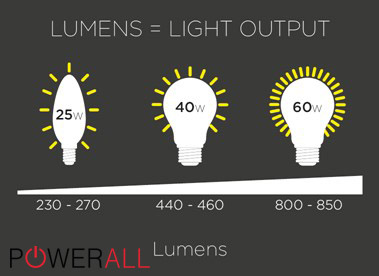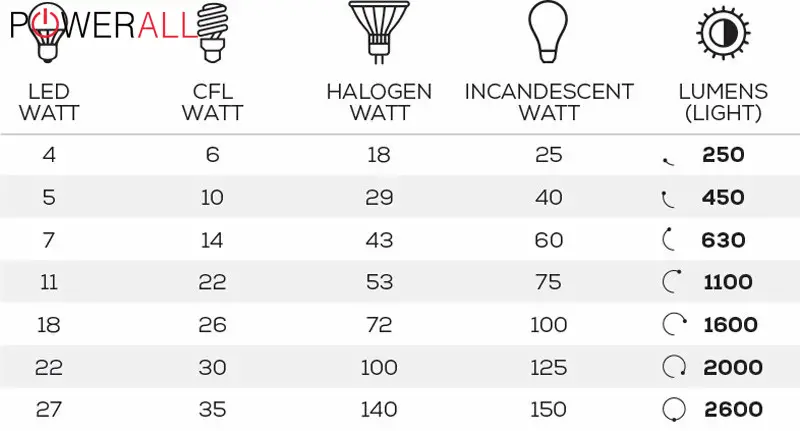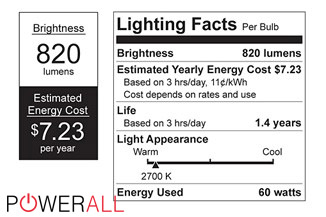When shopping for light bulbs, it’s easy to get overwhelmed by all the different terms and measurements. One of the most important factors to consider is its brightness, which is typically calculated in lumens. So, what LED is equivalent to a 100w bulb? Let’s find out the answer in this post.
What Does Lumen Mean In Light Bulbs?

In the context of a light bulb, “lumen” refers to a unit of measurement for the amount of visible light emitted by the bulb. It is a measure of the brightness or intensity of the light and is commonly used to compare the performance of different light bulbs.
In general, a bulb with a greater lumen rating will appear brighter than one with a lower lumen rating. For example, a typical 60-watt incandescent light bulb produces about 800 lumens, while a 100-watt bulb produces about 1600 lumens.

100W Bulb Lumens Conversion
As a general rule of thumb, a 100-watt incandescent bulb produces approximately 1600 lumens. This is based on the typical luminous efficacy of incandescent bulbs, which is around 16 lumens per watt.
However, the number of lumens produced by a 100-watt bulb depends on the type of bulb, as they have different efficiencies in converting electrical energy to light energy.
How Many Lumens Is A 100 Watt Bulb?
The LED bulb equivalent to a 100W bulb would be the one that produces around 1600 lumens of light output. Still, it’s important to note that the wattage rating of an LED bulb doesn’t directly translate to its brightness, as LEDs are more energy-efficient than conventional incandescent bulbs.
In terms of cost-saving, LED bulbs are significantly more cost-efficient than traditional incandescent ones. This is because they consume less energy to produce the same amount of light.
The former is estimated to use around 75% less energy than the latter, which can result in significant savings on electricity bills over time. Additionally, LED bulbs have a longer lifespan, so they need to be replaced less frequently, further reducing overall costs.
60w Vs. 100w Bulb: Which One To Choose For Optimal Brightness?
The choice between a 60W and a 100W bulb for optimal brightness would depend on several factors, including the size of the room and the specific lighting needs. In general, a 100W bulb will produce more brightness than a 60W bulb, but it will also use more energy.
Suppose you need a lot of light in a larger room; 100W bulb lumens may be a better choice. On the other hand, if you want decorative lighting for a smaller space or don’t need as much brightness, a 60-Watt bulb may be sufficient and more energy-efficient.
Here is a detailed comparison table for you:
| 60W Bulb | 100W Bulb | |
| Brightness (Lumens) | 800 | 1600 |
| Heat | Less heat production | More heat production |
| Resistance | More resistance -> eat up more power | Less resistance -> eat up less power |
How To Read The Light Bulb Label
With so many options available, it’s important to understand how to read the labels on light bulbs to make informed purchasing decisions.

Brightness
The brightness will be stated in lumens. The greater the number of lumens, the brighter the bulb will be. As a general rule of thumb, you’ll need around 800 lumens for a 60-watt light bulb replacement and 1600 lumens for a 100-watt replacement.
Yearly Cost
The yearly cost of a light bulb is the fee of running it for a year. With LED bulbs, the charge is typically much lower because they use less energy. Look for the estimated annual energy cost on the label to compare different types of bulbs.
Light Appearance
The light appearance of a bulb is measured in Kelvin (K) and refers to the color of the light it emits. Look for the light color temperature on the label to choose the right light appearance for your needs.
Energy Used
The energy a bulb uses is another important factor to consider when choosing a light bulb. When comparing bulbs, be sure to look at the energy used rather than the light intensity. This is because the former is a more accurate reflection of how much electrical power the bulb will consume.
Frequently Asked Questions
Are 100W Bulbs Brighter?
Not necessarily. The brightness of a light bulb is measured in lumens, which is a measure of the amount of light emitted by the bulb, rather than its wattage. It’s important to compare the lumens when choosing a bulb rather than simply looking at the wattage. This will ensure that you choose a bulb that is bright enough for your needs.
How Many Watts Is 100W LED?
On average, a 100-watt LED bulb will consume only 17 watts of power rating while providing a similar level of intensity as a 100-watt incandescent bulb. This means that this bulb will be much more energy-efficient and cost less to operate than a 100-watt incandescent one.
Is 800 Lumens Too Bright?
No. A brightness of 800 lumens can be considered bright, but it’s not necessarily too bright for every situation. For example, 800 lumens may be too bright for a small bedroom where softer decorative accent lighting is desired. But it may be ideal for a larger space like a living room, kitchen, or office where brighter, task-oriented lighting is needed.
Is 3000 Lumens Too Bright?
Yes.
Brightness levels of 3,000 lumens are typically regarded as appropriate for industrial or commercial environments. When used at home, it might be excessively bright for some areas, such as living rooms or bedrooms, which could lead to eye fatigue or pain. For these areas, it is advised to utilize a lower lumen level.
Is 5000 Lumens Too Bright?
Yes.
This level can be considered very bright, and it may be too bright for some situations, such as a small bedroom or living room where more ambient lighting is preferred. Still, 5000 lumens may be appropriate for larger spaces, such as warehouses, commercial spaces, or outdoor areas.
The Bottom Line
You finally have the answer to this question about the lumens 100-watt bulb. While a 100-watt bulb was once the norm for producing bright light, it is no longer the most energy-efficient or ecologically friendly choice.
By upgrading to an LED light with a lower wattage and better lumen output, you can have the same level of light while improving your energy savings.









0 Comments